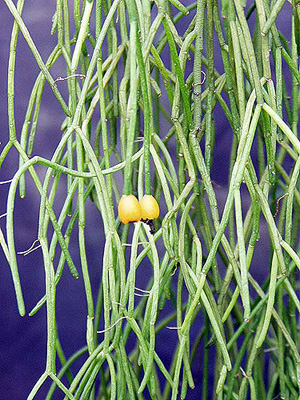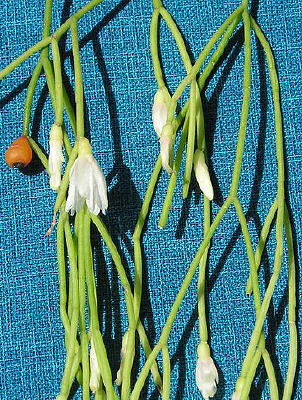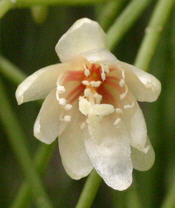R. campos-portoana from underneath the bell-like flower. (© Ken Friedman) |
|
"This plant was collected by Dr. Rose and Campos Porto in July 1915 (No.20612) and flowered in the Jardin Botanico do Rio de Janeiro in September of that year, and from this the description was drawn. Dr. Rose brought home living specimens but these have not yet flowered." DISTRIBUTION.- Brazil (S & SE Minas Gerais, SW Espirito Santo, Rio de Janeiro, Sao Paulo, Parana, E Santa Catarina): epiphyte in Atlantic and cloud forest, to 2300 m altitude. |
||
R. cribrata (Lemaire) N.E. BrownNote from Bradleya 13 The oldest name for this orange-fruited species may be R. cribrata (Lemaire) N.E. Brown (Hariota cribrata Lemaire in Ill. Hort. 4, misc.:12.1857), but it cannot be properly typified and in the absence of fruit data could also apply to the very similar R. burchellii Britton & Rose and R. juengeri sp. nov. Schumann (1890: 277-278) misapplied Lemaire's name to a form of R. cereuscula, while later authors used it for forms of what is now known as R. teres, and thus it seems best to abandon it as a source of uncertainty and confusion. |
||
Desc from Hunt 2006.
Body pendant up to 4m, pale green; primary branches about 50cm, reddish only briefly at apex; branch segments naked or with inconspicuous bristles at apex, arising in groups of 2-4, the terminal 2-4cm x 2-2.5mm; flowers like R. burchellii but only ca 1.5 x 1cm; pericarp 3x2mm; stigma 3-4, up to 2.7mm; fruit ovoid to globose, 5-7mm, orange
[ From Löfgren in Arch. do Jard. Bot. do Rio de Jan. 2: 35-36. 1918]
1 -Rhipsalis campos-portoana n. sp. (Illustration VII.)
Caulis declinatus vellonge pendulus, cylindricus articulatus, perfecte glabrus. Articuli dichotomi, vel ultimi 3-4 verticillati, primariis 50 ctms . vel ultra longi, secundarii 15-25 ctms. et celeris gradatim reductis, ultimis 4-5 ctms. longis 2 millim. diametralis, ad articulationes leviter incrassatis. Areolis distantes, squamis primum purpureis demum palaeaceis, late triangularis, seta et lana carentes. Flores lateralibus subterminalis, albo hyalinis; bacca parva, globosa, rubra. Floret mense Setembro-Octobro.
-
Plant - epiphytic, up to 2 m long with the pendant primary segments, frequently more than 60 cm. long and at most 5 mm. diam, cylindric. The first branching is dichotomous, 15-30 cm. long and 3-4 mm. diam, slightly nodular in the joints.
-
Areoles relatively distant and small, superficial, with scales, first red that after drying become straw coloured and membranous, broad-triangular, lightly mucronate, without bristles nor woolly cushions underneath.
-
Terminal segments 4-5 cm. long and always more or less 2 mm. diam. New sprouts are cylindrical, clear green, as are also the scales.
-
Flowers pseudo terminal, that is they are on the side or edge of the extremities, at times even in the next to the last segments and they don't open completely, keeping a slightly campanulate shape with the apex of the petals reflexed, which constitues a big difference to the species Rh. cribrata that is very close, but with flowers always well campanulate. Tepals always decreasing in size inwards. In total 14-15, being 4-5 external, almost scale-like and 10 interior, oblong, to a max of 9 mm. long, sublinear, obtuse and apex slightly cucullate, rarely reflexed.
-
Stamens are little more than half the length of the tepals, with clear yellow filaments, almost hyaline and anthers white.
-
Style is almost of the size of the tepals, with the stigma 3-4 radiated, and lobes reflexed, tube white-hyaline.
-
Ovary is lightly turbinate, up to 4 mm. diam.
-
Berry is clear ruby-red and subglobose when it ripens, with maximum 5 mm. diam and little less in height.
The position of this species is close to Rh. cribrata, in the subgenero Eurhipsalis, from which it differs in thicker branches, nodules in the joints, smaller flowers, with less numbers of tepals and they are never campanulate.
It blooms in the months of September-October and it is in cultivation in the Botanical Garden.


